International experience01.06.2024
Development of local content for RES projects: international experience
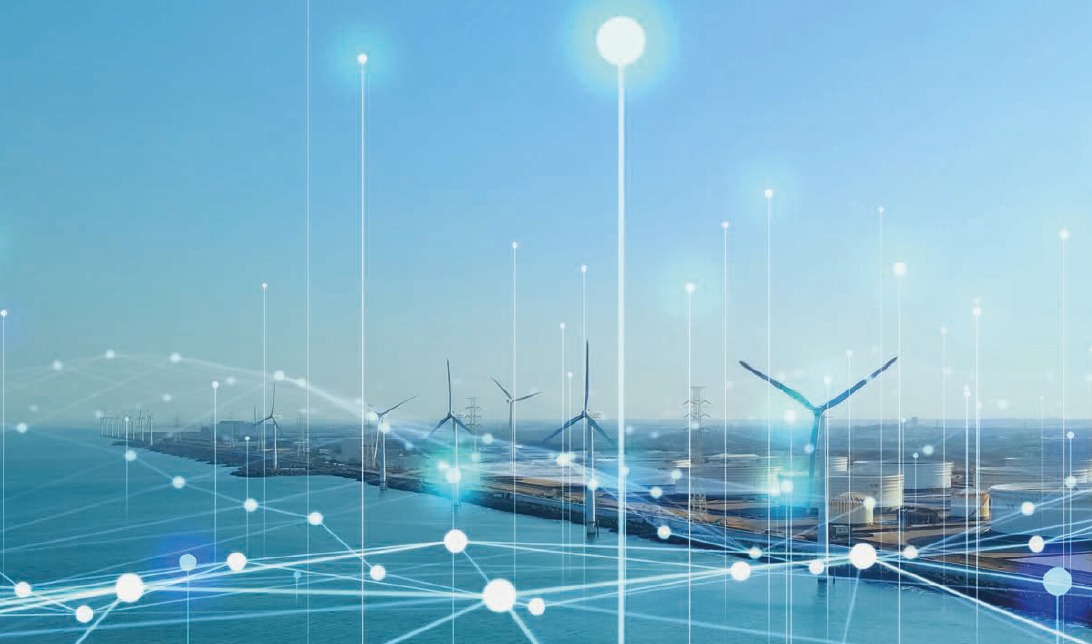

Timur Shalabayev, Executive Director, Qazaq Green RES Association
The issue of the development of local content within the framework of the implementation of industrial and infrastructure projects in the Republic of Kazakhstan is one of the most urgent. The solution of this issue is aimed at supporting domestic producers of goods, works and services.
The President at a meeting with business representatives held on September 12, 2023 paid special attention to the development of local content, especially noting that many states actively apply measures to protect the domestic market. However, he noted that strict requirements for local content should be applied to enterprises that receive public contracts and at the same time admitted that only goods that cannot be produced in the country should be imported.
The problem of developing local content for RES sector has also been repeatedly raised at various levels over the past few years. Thus, the President of the Republic of Kazakhstan K.K. Tokayev at a meeting on development of the electric power industry and renewable energy, held on May 21, 2021, set a clear task for Government of the Republic of Kazakhstan to make proposals for localization of production of components and other elements of RES structures and energy in general. However, in general, the task was not completed.
International experience in development of local content for RES sector
Despite the ambitious goals for development of RES sector, researchers note that the requirements for development of local content make renewable energy sources more expensive than necessary, thereby exacerbating rather than mitigating climate change[1].
In particular, it is noted that local content requirements — rules requiring companies to use a minimum level of domestic goods or services supplied domestically — directly distort trade and encourage import substitution with domestic goods, even if domestic goods are worse and more expensive than foreign imports. Such trade distortions hinder competition and increase the overall costs of electricity producers in the short term. For example, between 2014 and 2017, local content requirements led to an increase in the cost of solar photovoltaic energy generated in locally owned projects in India by 6 percent per kilowatt hour compared to similar projects that do not meet the same requirements. During the same period, Indian solar panels remained about 14 percent more expensive than imported panels[2].
Local content requirements also often lead to local manufacturers specializing in relatively simple components, such as housings and bearings, which can usually be used in other production chains. Over-specialization in such basic goods undermines the efficiency and competitiveness of industry and discourages investment in new technologies.
Local content requirements are most often introduced as a precondition for access to government programs that guarantee above-market prices to renewable energy producers, known as feed-in tariff programs. They are also introduced as part of the qualification requirements in government tenders for renewable energy sources.
Since 2014, high-income countries have increasingly included local content requirements in the processes of public tenders for solar photovoltaic and wind energy.
Analysis of the local content policy for RES sector in 29 countries conducted by the Peterson Institute of International Economics shows that the requirements for local content were mainly applied within the framework of feed-in tariff programs or as part of participation in public tenders.

16 of the local content policies analyzed were prerequisites for becoming eligible for FiT fixed tariff program and receiving bonuses, 9 were prerequisites for public tenders for renewable energy sources, 3 were prerequisites for access to public financing and 3 were prerequisites for both eligibility for FiT fixed tariff program, and for public tenders.
At the same time, it should be borne in mind that local content requirements within the framework of open auctions are less common practice, since they entail risks of hidden subsidies for local production, which contradicts international trade rules. In particular, attempts to launch such auctions in India as part of the National Solar Mission and in Canada (Ontario) led to proceedings within the framework of the World Trade Organization and, ultimately, the closure of such auctions.
Nevertheless, a number of countries use local content requirements in one way or another as part of industrial development support for RES sector. For example, in the Australian Capital Territory, each applicant's local content proposal accounted for 20 percent of the positive assessment of its solar energy offer in 2014 and 7.5 percent in 2020.
In Japan, local content includes stakeholder engagement experiences and impacts on employment and production at the local and national levels, and scored 40 out of 240 in the evaluation of offshore wind energy bids in 2020.
In Taiwan, the bid requirements are particularly strict. To participate in the 2022 offshore wind energy auctions, applicants must commit to locally purchase 26 "key components" installed by the Taiwan Industrial Development Bureau (IDB) for at least 60 percent of the proposed capacity. In addition, to become qualified bidders, candidates must score at least 10 points for "points-adding items." This means that they must either purchase locally more key components than required, or purchase locally other elements that the IDB considers to be points-adding factors."
Germany also uses green requirements for local content, but more purposefully. Thus, in order to encourage the spread of wind energy in southern Germany, the Renewable Energy Act 2021 stipulates that 15 percent of successful tenders between 2021 and 2023 should be awarded to power plants in southern Germany. In the period from 2024 to 2028, this quota will increase to 20 percent.
Until recently, the United States did not have a national policy on local content in the field of renewable energy. Previously, the United States restricted imports through the introduction of anti-dumping and countervailing duties (AD/CVD). For example, on December 7, 2012, the U.S. Department of Commerce, through AD/CVD orders, imposed 30 percent import duties on crystalline silicon photovoltaic products (CSPV) from China.
However, some states that have tried to adopt a local content policy for renewable energy have rejected it as too expensive. California and Washington implemented FiT programs in the mid-2000s, which continue today, but Massachusetts, New Jersey and Ohio rejected their local content requirements for renewable energy after three years or less.
However, the $1.2 trillion Infrastructure Investment and Job Creation Act (IIJA), signed by President Biden on November 15, 2021, does include basic requirements for domestic procurement of infrastructure materials, fulfilling the president's promise in 2020 to support U.S. industry through local content requirements.
The Law essentially prohibits the use of federal financial assistance for infrastructure if the iron and steel, industrial products, and building materials used in the project are not manufactured in the United States, although there are several exceptions. Exceptions include: (1) when the use of domestic products increases the total cost of the project by more than 25 percent, (2) when the application of the "buy American" policy would be incompatible with the public interest, and (3) when iron, steel, manufactured products and building materials produced in the United States are not in reasonable quantities or of unsatisfactory quality.
According to the Law, for solar and wind energy projects launched before 2025, preferential bonus credits are awarded if 40 percent of the project's resources are obtained from internal sources. This percentage will increase to 45 percent in 2026 and to 55 percent thereafter. In addition, the Biden's administration has also stated that it will seek to protect domestic producers by imposing countervailing or anti-dumping duties on imported renewable energy sources if trading partners use unfair subsidies or export products at a price below cost.
Thus, the researchers note that despite all their good intentions, local content requirements for renewable energy projects tend to increase costs, impede international competition, and increase investment risk and uncertainty by hindering rather than encouraging local production. If the goal of renewable energy policy is to make solar photovoltaic and wind energy more affordable and widely used, local content requirements are an obstacle, not a solution[3].
Then, we will consider in more detail several country cases on the promotion of local content policy on the example of Russia, Uzbekistan, Brazil and India.
The experience of the Russian Federation in the development of local content for RES sector
The Russian Federation is pursuing an industrial policy of import substitution. In particular, prices on the wholesale electricity market and the capacity of generating facilities operating on the basis of renewable energy sources depend on the qualification of the generating facility, which in turn depends on the degree of localization in the Russian Federation. Moreover, localization requirements are also imposed on participants in the retail renewable energy market (except for generation due to biomass, biogas).
Rules for determining the price of the capacity of generating facilities operating on the basis of renewable energy are approved by the Decree of the Government of the Russian Federation "On Mechanisms for stimulating the use of RES in the wholesale market of electric energy and capacity" No. 449 dated May 28, 2013 (DGRF- 449).
This Decree (DGRF 449) introduced the concept of "degree of localization" into the Rules for Qualification of Generating Facility based on the Use of RES, approved by Decree of the Government of the Russian Federation No. 426 dated June 3, 2008 (DGRF 426).
DGRF 426 determines which components and operations and to what extent contribute to the calculation of the degree of localization. The generating facility and its components (equipment) must be partially manufactured in Russia. In order to create economic incentives for development of production of basic and (or) auxiliary generating equipment used in the production of electric energy using renewable energy sources on the territory of the Russian Federation, targets are set for degree of localization of the production of basic and (or) auxiliary generating equipment used in the production of electric energy using renewable energy sources on the territory of the Russian Federation. Since 2016, 70% of the generating equipment of solar power plants should be Russian-made. For wind power plants, the target localization rate is 55% in 2018 and 65% from 2019. For small hydroelectric power plants, the degree of localization is set at 65%. Failure to comply with them threatens the investor with a serious fine.
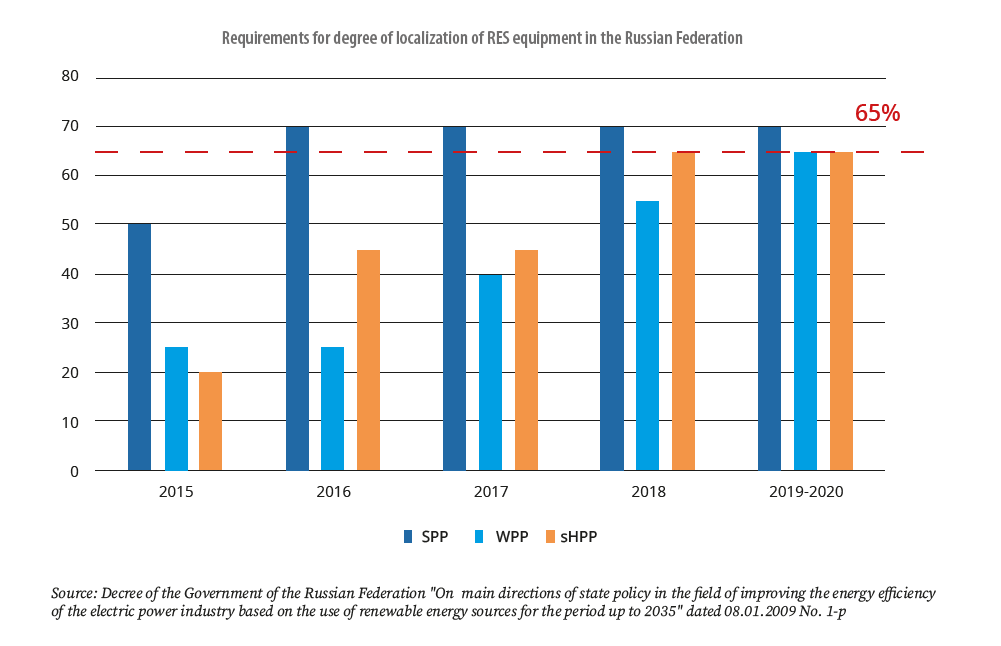
In general, it should be noted that the policy for development of RES in the Russian Federation is based on the principles of supporting local production[4]:
‒ involvement of innovative high-tech technologies and solutions in the energy sector and development of local production of high-tech generating and auxiliary equipment;
‒ transfer of innovative renewable energy technologies and creation of competencies in the field of design, construction and operation of renewable energy generation facilities;
‒ establishing effective cooperation between Russian industry and science with major international industrial companies;
‒ economic incentives for manufacturing the main and auxiliary generating equipment used in the production of electric energy using renewable energy on the territory of the Russian Federation formed the basis of the policy in the field of development of generation based on RES;
‒ As an incentive for development of domestic production, the support program provides targets for degree of localization of equipment used in the construction of power plants.
Thus, in accordance with GDRF 449, the Concept of development of renewable energy sources in Russia focuses on local production of power plants (generating facilities). The degree of localization is a crucial prerequisite for ensuring an economically attractive price for supplied capacity, which is a barrier for foreign manufacturers to enter the renewable energy sector of the Russian Federation.
Requirements for localization of production of basic and auxiliary equipment used in the construction of generating facilities based on renewable energy sources (RES) have led to the creation of new high-tech engineering cluster for production of equipment components for solar and wind energy, the global demand for which is constantly growing.
The main manufacturers of generating equipment for SPP in Russia are: GC Hevel, Solar Silicon Technologies and HELIOS-Resurs. The following scientific and production companies can also be distinguished: Telecom-STV (Zelenograd), Ryazan Plant of Metal-Ceramic Devices (Ryazan), Saturn (Krasnodar), NPP Kvant (Moscow). Thus, the production of photovoltaic modules was established in Russia.
The wind energy industry is dominated by three participants: the Wind Energy Development Fund (joint investment fund created on a parity basis by PJSC Fortum and the RUSNANO Group), NovaVind (part of SC Rosatom) and Enel Russia. Each of these companies implements its own approach to the localization of equipment, each investor has chosen a technology partner (vendor) to implement the localization program. The country has launched the production of gondolas, blades and towers for WPP in cooperation with foreign companies Vestas and Siemens. However, it should be noted that due to the outbreak of war in Ukraine, these companies announced the closure of production in 2022.
The following enterprises also produce solutions for small HPP in Russia:
1) hydraulic power equipment (with unit capacity of up to 50 MW): PJSC "Power Machines" (also electrical equipment for HPP/PSPP), JSC "Tyazhmash" (including a subsidiary of ČKD Blansko Holding a.s.), JSC "Uralgidromash", LLC "Voit Hydro", LLC "Ruselprom" (also electrical equipment for HPP/HPSPP);
2) hydrogenerators (with unit capacity of up to 50 MW): Elektrotyazhmash-Privod LLC, PJSC NPO Elsib (also hydrogenerator excitation systems);
3) microhydroelectric power plants (with unit capacity from 0.01 to 5.6 MW): MNTO "INSET".
Rather strict requirements for local content, import substitution policy, the war in Ukraine and the withdrawal of a number of manufacturers from the Russian market are key factors in the low level of RES development in the country as a whole. As of January 1, 2023, the installed capacity of solar power plants in Russia amounted to more than 2.1 thousand MW, wind power plants are also 2.1 GW.
Uzbekistan's experience in developing local content for RES sector
Uzbekistan's experience in supporting local content for RES sector differs significantly from the Russian experience. The country has not followed the path of setting targets for local content. To date, measures to support renewable energy sources include: tax preferences for manufacturers of equipment and "generators" of RES, compensation for cost of purchasing equipment, subsidizing interest rates.
Thus, for example, RES plant manufacturers are exempt from paying all types of taxes for a period of five years from the date of their state registration. In addition, renewable energy producers and producers of RES plants are granted the right to create local networks (electric, thermal and/or gas) and conclude contracts with legal entities and individuals for sale of electric, thermal energy and (or) biogas produced from RES supplied through the local network[5].
In order to support the widespread use of renewable energy sources, from October 1, 2022, individuals will be given the opportunity to purchase solar and wind power plants and solar water heaters manufactured in the republic, with payment in installments without interest for 3 years at the expense of the Extrabudgetary Inter-Sectoral Energy Conservation Fund under the Ministry of Energy. Consumers are also given the opportunity to pay in installments or deduct the amount of compensation from the final retail price when purchasing renewable energy installations directly from domestic manufacturing enterprises, enterprises providing delivery, installation and start-up services at domestic retail facilities, including through e-commerce tools[6].
These measures made it possible to organize the production of equipment and components for RES sector in a short time. For example, Procab LLC has developed the production of specialized cables for solar panels. At the moment, the company is the first and only cable manufacturer in this field.
In Yangiyul, Tashkent region, the production of solar panels was launched in 2023. The plant has already been built, and equipment commissioning is currently underway on site. Enter Solar Green Energy will be able to produce 200 MW of equipment per year. This is 377.36 thousand solar panels. each panel produced at the factory will be designed for 540-560 watts. The company will operate around the clock.
SUN-HIGHTECH LLC is one of the largest professional manufacturers of solar photovoltaic plants in Uzbekistan. The company has developed a new technology for the production of solar modules based on the HJT heterojunction. The new generation modules combine the advantages of thin-film and crystal technologies. The efficiency of the cell is 23.5%, the power of the module is up to 340 watts.
Alutex, together with Proxima Energy, is launching the production of facade windows with integrated solar panels. Facade windows with solar panels are an innovative solution that makes it possible to receive electricity directly from sunlight. Such windows can be installed on the facade of the building. They can be used for both commercial buildings and residential buildings.
The "subsidiary" of the Kazakh company Renerca intends to invest over $34 million in the project. With the participation of Renerca (Free Volt), up to 40,000 sets of solar cells will be produced per year. The company invests more than $34 million in production.
MIR SOLAR LLC is a leading manufacturer of solar systems in the Republic of Uzbekistan. The company is engaged in production of photovoltaic plants for generating electric energy and solar water heating plants. Photovoltaic plants include solar panels developed and manufactured at the enterprise, electronic control units, which, at the customer's request, are equipped with rechargeable batteries and the most economical indoor and street lighting systems based on high-brightness LEDs.
Thus, tax preferences, coupled with programs to subsidize the purchase of domestic equipment, made it possible to launch production of generating and auxiliary equipment for RES sector (photovoltaic modules, solar collectors, solar cable, etc.) in a short time.
Brazil's experience in supporting local content for the renewable energy sector
In Brazil, local content is not a prerequisite for participation in auctions and is not a criterion for evaluating bids. Local content requirements are necessary to obtain cheap financing from the BNDES National Development Bank as part of its Finem program[7]. The bank's financing is carried out in Brazilian reals, which eliminates high currency risks, since all electricity purchase agreements are denominated in local currency.
If the project uses equipment manufactured outside Brazil, such a project is not eligible for a loan from BNDES, which assumes interest rates half as low as those offered by commercial banks. BNDES offers concessional financing of up to 80% of the total cost of the project at an interest rate of 7-9% for up to 20 years. Between 2004 and 2018, BNDES accounted for more than 70% of the total debt financing of renewable energy projects in Brazil[8]. Thus, most of the wind farms in the country were implemented with the help of these requirements and financing from BNDES.
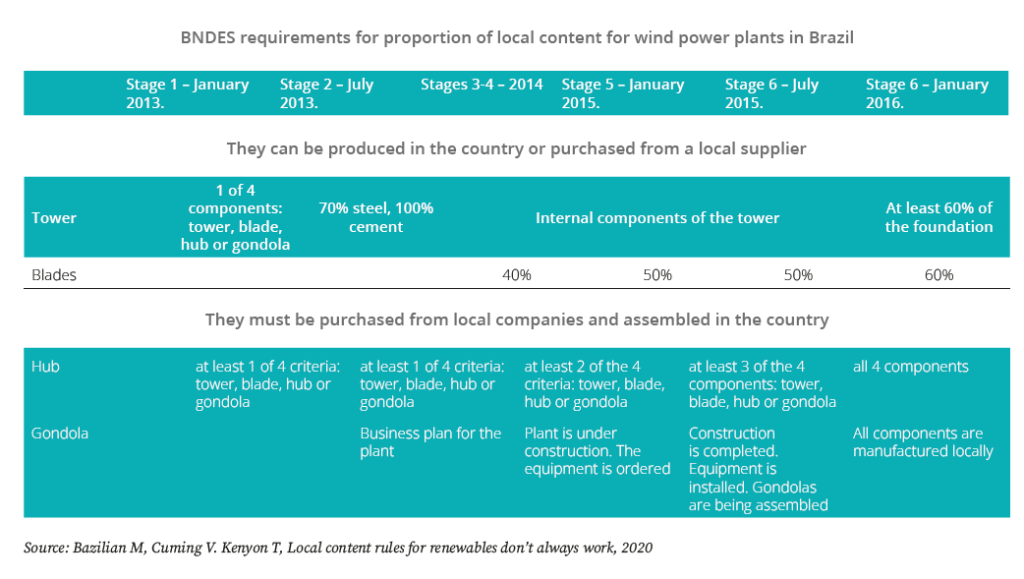
Thanks to these support measures, Brazil has developed a wind industry specializing in less technologically complex components such as blades, towers, bearings and castings – because they are easier to produce locally and transport throughout the country. Thus, by 2016, the country had 8.7 GW of blade production capacity, of which the share of domestic companies was 79%.
At the end of 2016, local companies accounted for only 6% of the 1.6 GW gondola production market, which was divided between foreign companies: Enercon (Germany), Vestas (Denmark), GE (USA), and Siemens Gamesa (formerly Spain, now Germany, after the merger in 2016).
As for supporting the development of solar energy, it should be noted that since 2015, the sector as a whole has experienced difficulties with the supply of equipment, high financing costs and uncertainty about the demand for this type of energy in the future. In particular, in 2015-2017, there was a decrease in auctions for SPP in the country. In this regard, historically, uncertainty about the demand for photovoltaic energy in Brazil has meant that international suppliers have been reluctant to initiate production in the country. However. BNDES has developed local content requirements for SPP projects.
Currently, SPPs that plan to receive funding from BNDES must use PEM assembled in the country using metal frames produced in the country. Electronic components and metal structures must also be purchased from local manufacturers.
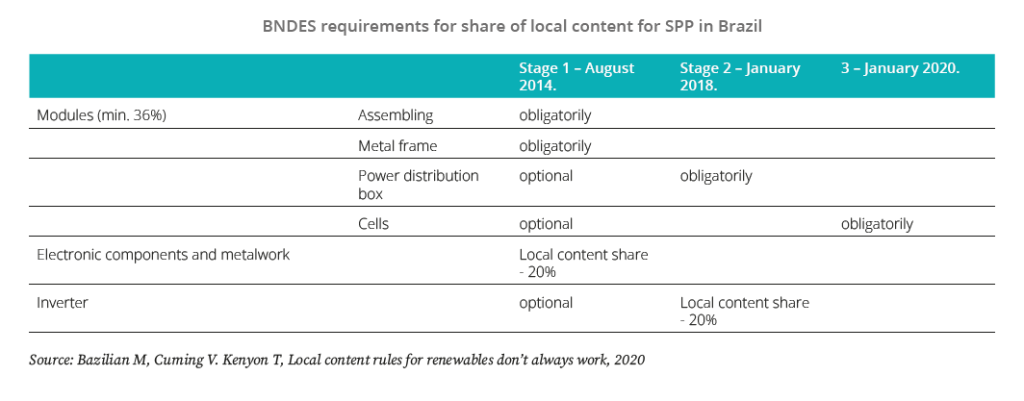
It should be noted that the requirements for local content for solar energy did not have a proper impact on development of the local content market due to uncertainty about the volume of auctions for SPP in 2015-2017. Despite the fact that the Government has prepared new auctions for the sun, BNDES predicts that they will not help form the local photovoltaics manufacturing industry.
India's experience in developing local content for RES sector
In India, the demands for local content and the desire to form a domestic renewable energy manufacturing industry were at the center of the National Solar Mission. This initiative aimed at providing 20 GW of grid-connected solar parks in India by 2022 in order to create "favorable conditions for development of production facilities for solar energy and achieve an established annual production capacity of 4-5 GW by 2020.
At first stage of program (2010-12), the rules of local content applied only to crystalline silicon technologies, but at the second stage (2013-2017), project developers had to use locally produced photovoltaic systems to participate in "DCR" (domestic content requirement) auctions held within the framework of the National Solar Mission. Alternatively, they could participate in the "Open" category, where local content requirements were not applied, or in both types of auctions by submitting separate bids.
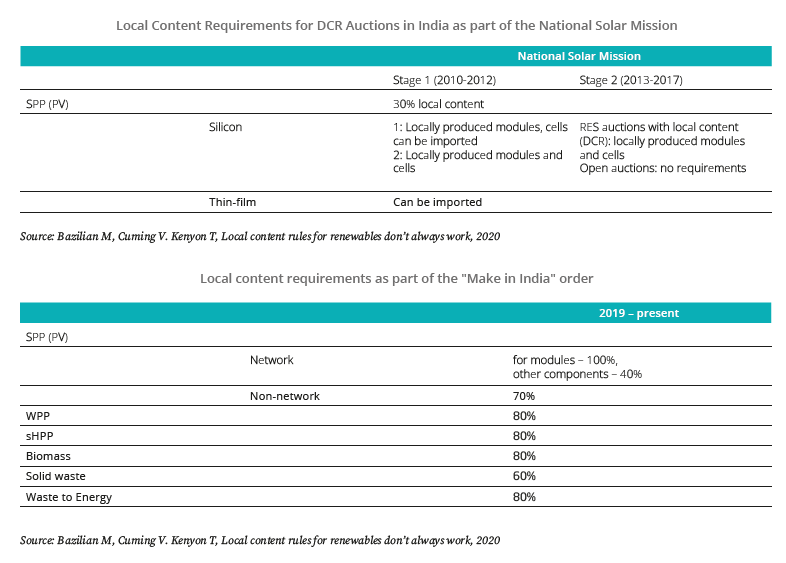
In 2016, conflict arose between the United States, supported by the WTO, and India that the local content requirements under Stage 1 and 2 break international trade rules and constitute unfair competition with respect to imported cells and modules.
The Government of India has been instructed by the WTO to remove local content requirements from RES auctions. Over the next 2 years, the United States repeatedly stated that India had not complied with the WTO decision and asked for retaliatory measures. As a result, the last auctions with local content (DCR) were held in December 2017.
At the same time, it is noted that even within the framework of auctions, the winners preferred to buy thin-film modules, since they were cheaper and accompanied by cheap financing. It was also difficult to compete with Chinese imports due to low prices.
In December 2018, the Ministry of New and Renewable Energy (MNRE) approved an order to launch a new "Make in India" program for public procurement in the clean energy sector. The order applies to renewable energy projects proposed by the federal government, ministries and quasi-public sector enterprises" (companies in which the federal government owned at least 51% of the shares). The required share of local content should vary depending on the technology: 100% of solar modules for grid-connected power plants and 70% for autonomous/decentralized solar projects.
The Make in India order was implemented through the CPSU program, according to which government organizations should hold auctions for 12 GW by 2022. In parallel, the PM Kusum program was launched with a budget of 5 billion US dollars for the installation of solar water pumps for farmers, where the requirement was to use locally produced equipment.
National certification program has also been launched, requiring that any manufacturer wishing to sell WPP turbines in the country must have a quality certificate for their equipment with a local assembly unit and an operation and maintenance (O&M) team. This was done to deter Chinese companies from opening production facilities in India.
After the announcement of the launch of the program, domestic manufacturers such as Adani Solar have already announced that they intend to expand the capacity for production of cells and modules. Developers of RES projects without local capacity may have to enter into deals with local suppliers or build their own facilities. Some Chinese companies are expected to accelerate their plans to manufacture modules and cells in India. For example, Longy Green Energy has announced plans to build a plant for production of cells (500 MW) and modules (500 MW)
Before the start of the program, the country had already developed the production of components for WPP. Large domestic and international turbine manufacturers had production and assembly lines in India and received most turbine parts from local suppliers, as production costs were low and transportation of large parts was expensive.
Conclusion
Today, the auction market for selection of RES projects attracts private domestic and foreign investors, the process of their internal procurement activities is unregulated by the state. Each investor independently gives preference to one or another equipment manufacturer, based on the main indicators of its financial model, because at auctions the decisive factors are the lowest price and the proposed amount of installed capacity.
[1] Hogan M., Local content requirements threaten renewable energy uptake, Peterson Institute for International Economics, 2021
[2] Benedict Probst, Vasilios Anatolitis, Andreas Kontoleon, and Laura Diaz Anadon, "The Short-Term Costs of Local Content Requirements in the Indian Solar Auctions," Nature Energy 5 (November 2020): 842–50
[3] Hogan M., Local content requirements threaten renewable energy uptake, Peterson Institute for International Economics, 2021
[4] Decree of the Government of the Russian Federation "On the main directions of state policy in the field of improving the energy efficiency of the electric power industry based on the use of renewable energy sources for the period up to 2035" dated 08.01.2009 No. 1-р
[5] The Law of the Republic of Uzbekistan "On use of renewable energy sources", Decree of the President of the Republic of Uzbekistan dated 22.08.2019 No.ПП-4422
[6] Decree of the President of RU "On additional measures for introduction of energy-saving technologies and development of low-power RES"
[7] Bazilian M, Cuming V. Kenyon T, Local content rules for renewables don’t always work, 2020
[8] Abdulrasheed Isah, Michael O. Dioha, Ramit Debnath, Magnus C. Abraham-Dukuma & Hemen Mark Butu, Financing renewable energy: policy insights from Brazil and Nigeria, 2023
Kazakhstan and UAE reaffirm strategic energy partnership with 1 GW wind project
Solar becomes EU’s top power source for the first time ever
How decentralised renewables transform healthcare services in rural Zimbabwe
Chinese company to build solar and wind power plants in Kyrgyzstan
Seaturns raises €2.45 million to industrialize wave energy technology and accelerate global rollout
Trump signs executive order to end subsidies for wind and solar energy
Uzbekistan's solar and wind power plants generate 5 Billion kWh since beginning of the year
Green Corridor Alliance JV registered in Baku to promote green energy development in Central Asia and the South Caucasus
In the EU renewable energy supply grew by 3.4% in 2024
IRENA accepting renewable energy project proposals in Central Asia until August 15
Astana to host Electronica Expo Kazakhstan Electronics Exhibition
WB gives rundown of Azerbaijan's green energy grid volume prospects
US solar sets new records as renewables nearly match natural gas – EIA
‘Wings’ on poles: Bill Gates-backed breakthrough wind turbine facility breaks ground
Perovskite tandem solar cell achieves new efficiency record
Kazakhstan and China endorse draft SCO joint statement on sustainable energy development
Innovative research on organic solar cells for space applications
Kazakhstan and Uzbekistan drive green energy progress in Central Asia
KazMunayGas launches pilot green hydrogen project in Atyrau
How private homeowners in Kazakhstan can make money from solar panels











